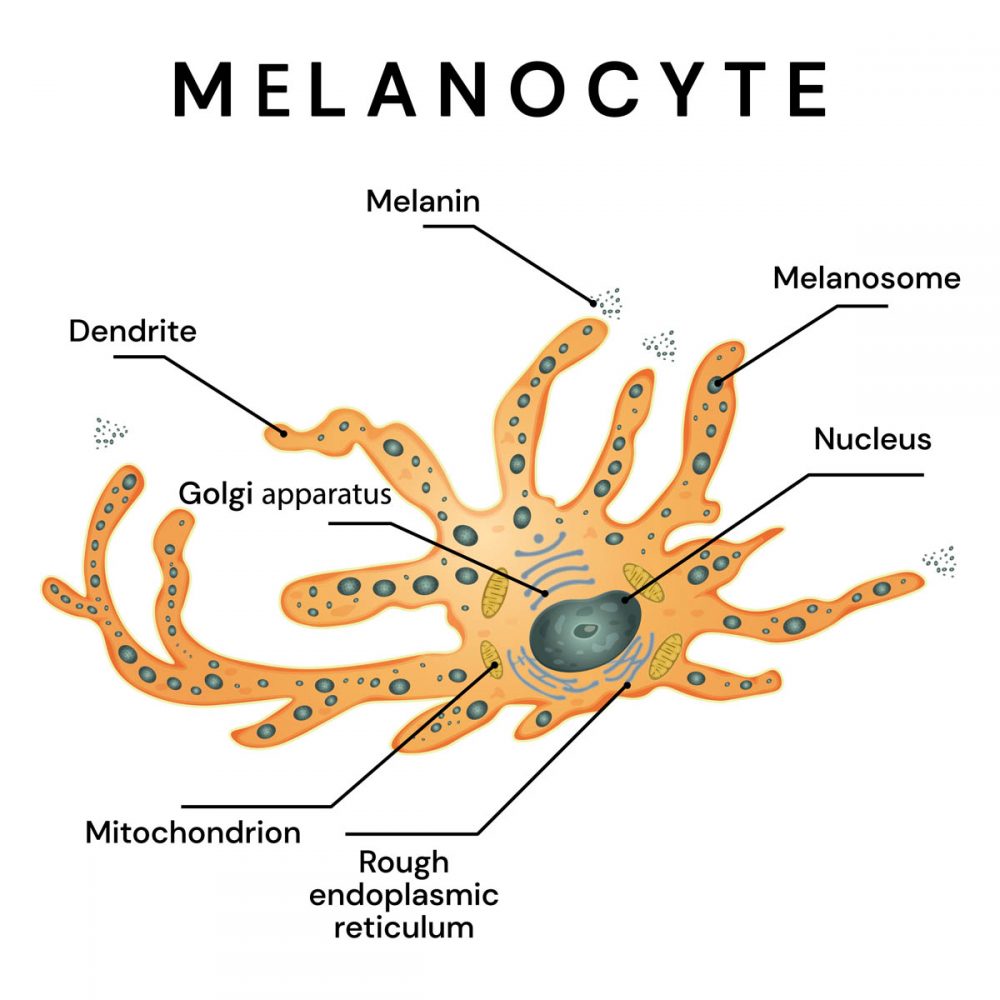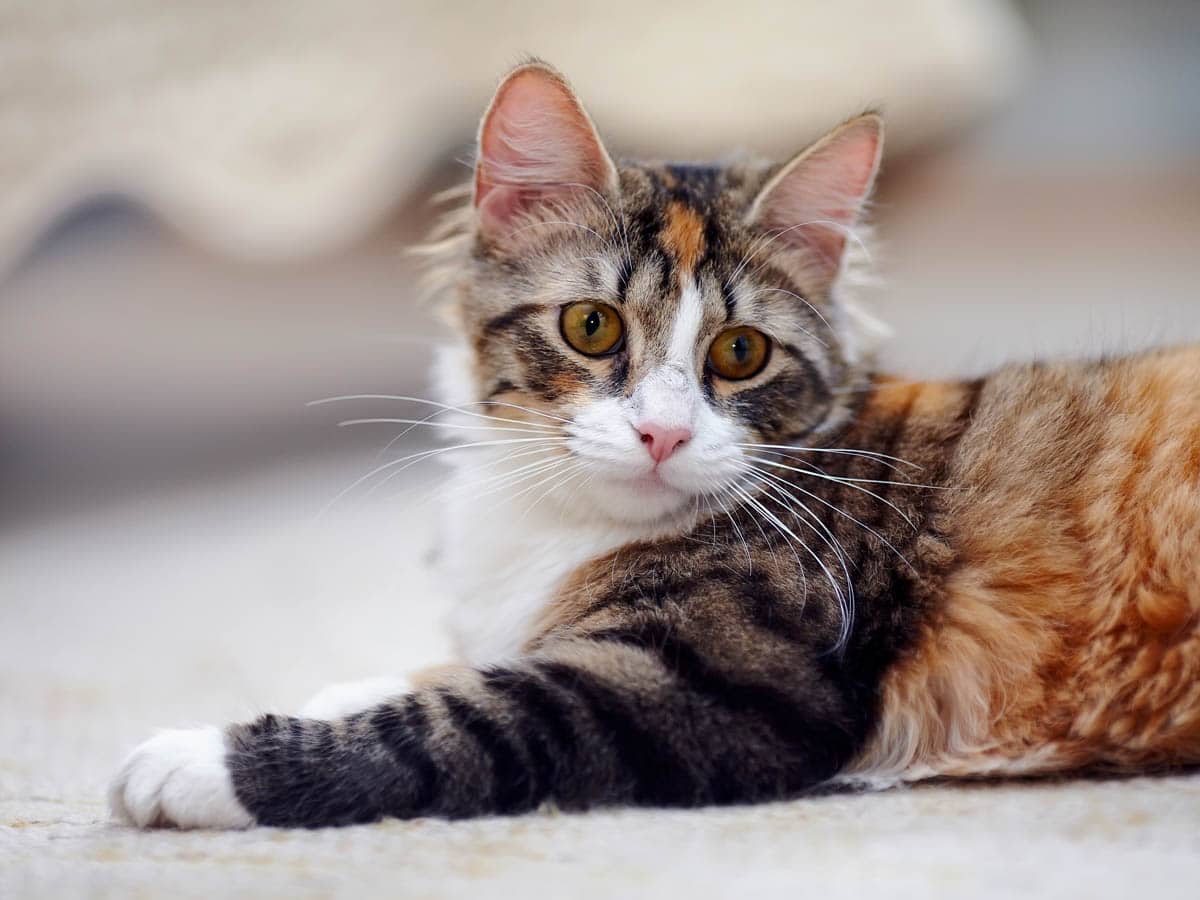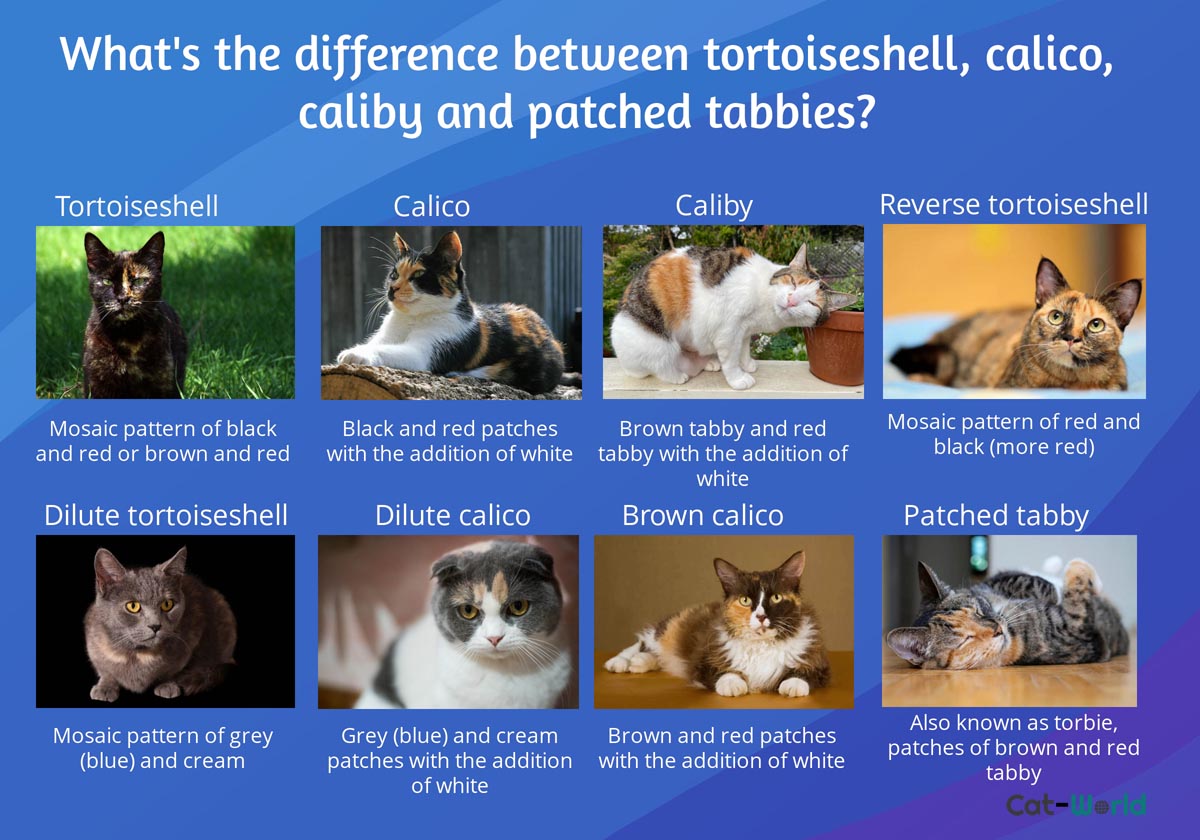What are Calico and Tortoiseshell Cats?
Calico and tortoiseshell (tortie) are both common coat colours/patterns which appear almost exclusively in female cats. The terms calico and tortoiseshell are often used interchangeably, and it is easy to see why. Both patterns refer to a multi-coloured cat which may consist of black and orange, brown and orange, grey and cream with or without white.
The calico and tortie coat colour/pattern occurs in both random-bred as well as purebred cats with both long and short coats.
The Main Difference Between Calico and Tortie Cats
Both cats are equally beautiful – that goes without saying. However, to the untrained eye, it can be difficult to tell the difference between calico and tortie cats. How do you differentiate one from the other? There are two ways.
First, look for white. Secondly, check to see how many colors there are: two vs. three.
Tortoiseshell cats will have no white in their coats. Their coloring will be a mixture of shades, including black and orange (most prominent) resulting in a brindle effect. On the other hand, calicos do have white. They are truly tricolored. Black, orange, and white will all be present in spots and patches from head to tail.
So, how to know for sure whether it’s a tortie or a calico?
Check for three colors. If you see black, red-orange, and white…it’s a calico!
What Causes Calico and Tortie Color Patterns
When discussing why cats look the way they do, it helps to have a basic understanding of feline genetics. In the next section, Cat World will explain the effect of sex-linked O genes in depth. For now, just know that colors and patterns are determined by chromosomes.
Felines are like humans. They can have both X and Y chromosomes. Two X’s result in a female cat and an X and a Y produces a male cat. From there, these X chromosomes are responsible for determining fur color. Tortie-colored cats have both orange and black versions of these genes (also known as the “XB allele” and “Xb allele,” thus giving them that instantly recognizable tortoiseshell appearance.
Calicos are a little different.
They have a separate genetic condition referred to as “piebalding.” Essentially, it leads to unpigmented skin and fur… AKA white.
The Sex-Linked O Gene

Melanocytes are cells that produce melanin, which are microscopic granules found in the hair, skin, and iris of the eyes. The size, shape and arrangement of melanin granules are responsible for the colour of the cat’s coat. Cats have two types of melanin, black-based eumelanin and orange-based pheomelanin. Eumelanin is spherical and absorbs almost all light, which gives black pigmentation, pheomelanin granules are elongated and produce the red coat colour.
The genes are located within the chromosome, and each gene has a fixed position within the chromosome known as the locus (or loci in plural), an allele is a variant form of a gene and is located at the same place (locus).
The O allele converts the production of black pigment (eumelanin) into orange (pheomelanin) and is located on the X chromosome. As the male (XY) only has one X chromosome he will be orange or non-orange. Male tortie or calico cats do exist (the incidence is 1/3000) due to an extra X chromosome which makes them XXY, however, they are almost always infertile.
O is dominant over black (non-orange), so if a male has the O gene, he will be ginger. Tortoiseshell and calico cats have two X chromosomes, one carrying the O gene, and the other non-orange (Oo). During development, one of the X chromosomes is switched off to prevent the expression of both X’s. This inactivation (known as lyonisation or x-inactivation) is random which is how the coat displays both orange and non-orange.
For the female to be ginger, she must carry the O on both X chromosomes (OO). If she receives two non-orange genes (oo), she will be another colour, the tortie has both orange and non-orange (Oo).
Female:
- OO female – orange
- Oo female – tortoiseshell
- oo female – non-orange
Male:
- OO male – orange
- Oo male – orange
- oo male – non-orange
You will notice some of the photos below show the coat colour has changed from black to brown or grey and orange has become cream, this is due to dilution and modifier genes.
Chocolate and Cinnamon (locus B)

Chocolate and cinnamon are due to a mutation in tyrosinase-related protein 1 (TYRP1) which changes the shape of eumelanin (black) pigment granules from round to an oval (chocolate) or rod (cinnamon) shape.
Dilution

The color, shade, and intensity of a cat’s coat have everything to do with gene expression. Occasionally, the melanophilin gene (MLPH) mutates in such a way as to hinder pigment production in tortoiseshell cats.
The recessive dilution (d) gene turns black into grey, chocolate into lilac, cinnamon to fawn, and red to cream. The cat must receive two copies (dd) of the dilute gene for the colour to be expressed. If the cat has one non-dilute and one dilute copy (Dd), the coat will be dark (black, chocolate or orange) but carry the dilution gene, which can be passed on to offspring if the cat mates with a cat also carrying the dilution gene.
Even rarer is the dilute calico.
Instead of the bright tri-color black, orange, and white, you will see more grey, gold, and silver. They are a paler version of the calico. In fact, they are sometimes called “Clouded Tigers.”
What is the Difference between Tortoiseshell, Calico, and Torbie?
Tortoiseshell

The coat of the tortoiseshell cat is a mosaic of randomly patched black and orange (brindle), or its dilute version, grey (sometimes referred to as blue) and cream.
Calico

Also known as a tri-colour, the calico coat consists of black or brown with orange or cream, and the addition of white caused by the dominant white spotting gene (Ws).
The amount of black/brown, orange/cream and white can vary considerably between cats. Calico cats tend to be less brindled (although that is not always the case), with clearer and larger patches of orange and non-orange. Cats with more white have larger and more distinct patches of orange compared to the random pattern in tortie cats.
Torbie (Patched Tabby)
The torbie cat has the tortie coat colour along with the tabby pattern hence the name torbie (tortoiseshell-tabby). If the cat also has white, it will be a torbie and white, as with calicos, the more white in the coat, the more distinct the patches of colour will be. A torbie and white is also referred to as a caliby.


8 Types of Tortoiseshell and Calico Cats
It might surprise you to learn that there are multiple types of tortoiseshell and calico cats. In total, eight. Each has its own color and patterns which make them distinct.
Not sure which umbrella your cat falls under?
Read the descriptions below to find out.
- Tortoiseshell Cats: These cats have giveaway coats that resemble the shell of a tortoise. Almost always female, their fur will be a speckled or patchy blend of typically two colors: black, red, orange, or cream – but no white.
- Calico Cats: Conversely, the coat of a calico will contain white. From small blotches to large swatches of fur, a calico is a tri-colored cat.
- Caliby Cats: this term combines the words “calico” and “tabby.” Most commonly found in random-bred cat populations, caliby cats are a stunning combination of orange and brown tabby with some white as well.
- Reverse Tortoiseshell Cats: fondly referred to as “torbies,” these cats will have the stripes of a tabby paired with traditional tortoiseshell markings.
- Dilute Tortoiseshell Cats: As the name implies, dilute tortoiseshell cats are much more muted in color. This can come across as a softer, more pastel light blue to grey to cream. Why? Because of a melanophilin gene mutation.
- Dilute Calico Cats: As mentioned prior, dilute calicos are harder to find. These cats still maintain their classic tricolors, but they are faded due to the dilute gene.
- Brown Calico Cats: This is a particular variation of the calico that features significantly more brown coloring.
- Patched Tabby: Lastly, a cat who has red and brown or cream and grey tabby patterns (but zero white) would be considered a patched tabby. They often have an “M” on their foreheads, too.

Calico and Tortie FAQs
Do calico and tortie cats have distinct personalities?
Like all pets, calico and tortie cats will have their own unique personalities and character traits. However, this has less to due with gene expression and coat coloring, but rather everything to do with how a kitten/cat was raised and grew up.
Calico and tortie owners often both describe their cats as smart, independent, and spunky. Their temperaments are fun – and even a smidge sassy! Calicos are known to be quite talkative.
Do calico and tortie cats have any particular health concerns?
Tortoiseshell and calico cats are not a specific type of breed, and so they are no more at risk for health problems than the average cat.
Are tortoiseshell cats rare?
No, tortoiseshell is a common coat color and pattern which occurs in both random-bred cats as well as many cat breeds such as Burmese, British Shorthair, Devon and Cornish Rex, and Scottish Fold.
Are all tortoiseshell and calico cats female?
No, tortoiseshell and calico can occur in male cats, but it is extremely rare with an incidence of 1 in 3,000.
Are male tortie and calico cats always sterile?
According to the American Society for the Prevention of Cruelty to Animals, male calicos are indeed sterile. They are born this way. Likewise, male tortoiseshell cats have a rare extra X chromosome which would make them sterile… though male torties are exceptionally rare.
Are tortie and calico cats considered good luck?
Looking to add some fortune to your life? Consider a calico or tortie!
Japanese sailors would purposely keep a calico cat aboard a ship, as they believed these four-legged felines protected them against storms and danger. Similarly, tortoiseshell cats are held in high regard when it comes to ghosts. Apparently, they scare them away! The Irish also view tortoiseshell cats as good luck bringers.
Are tortoiseshell and calico cats friendly?
The personality of a cat is usually linked to how it grew up in the first weeks of life. A cat who was well cared for by its mother and had positive human interactions is much more likely to be a confident and friendly cat. However, many tortie cats do talk about tortitude and are said to be strong-willed.
